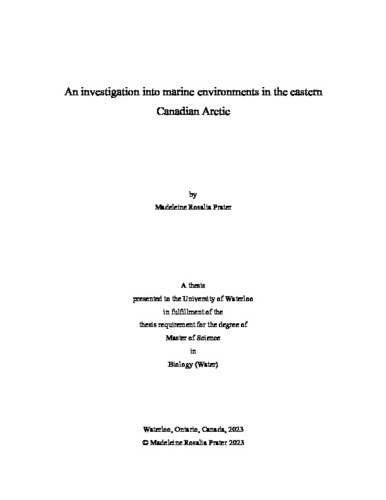| dc.description.abstract | Arctic marine environments are especially vulnerable to climate change, but detailed scientific data for these ecosystems are lacking due to their remote location and the associated logistical challenges of conducting research. Arctic marine ecosystems support the culture, well- being, and nutritive needs of northern Indigenous communities, and there is an urgent need to advance knowledge that can inform effective conservation and adaptation measures. To prioritize and facilitate research in understudied Arctic marine environments, Fisheries and Oceans Canada has identified certain marine areas as ecologically and biologically significant areas (EBSAs). EBSAs are considered to be uniquely important for the Arctic environment in general, and for certain species that frequent them.
In this thesis, I first focused on synthesizing recent research that is applicable to several EBSAs in the Hudson Bay Complex. Literature published between 2011 and 2021 indicates that changes in sea surface temperature and sea ice extent are impacting primary production patterns, which are causing bottom-up shifts that affect the entire food web. Projection models indicate that these bottom-up shifts will continue in future as warming increases and sea ice declines. The species of most concern, and most reported on, in the eastern Hudson Bay EBSAs was the COSEWIC-designated threatened eastern Hudson Bay beluga, which was the focus of 62% of papers published on biota. The review highlighted ongoing gaps in research, including studies of lower trophic level biota and whole ecosystems, and will be used during preparation of an upcoming Canadian Science Advisory Secretariat (CSAS) report.
In response to the lack of research conducted on lower trophic level biota and whole food webs (reported on in chapter 2), I conducted a study on marine food web structure in Frobisher Bay, NU. Inuit who rely on the fish, mammal, and invertebrate resources of Frobisher Bay have demonstrated an interest in learning more about food webs at a variety of depths, particularly in the context of increased industrial activity in the area (i.e., construction of a deep-water port that opened in July 2023). Mid- to lower-tropic level Arctic marine species were included in the analyses, and comparisons of food web structure were made among three different depths. The trophic ecology of understudied benthic suspension feeders and benthic carnivores was examined in more detail than other functional feeding groups, and compared among depths and between groups. Three depths were included: nearshore Frobisher Bay (10 to 15 m), midshore Frobisher Bay (20 to 45m), and offshore Frobisher Bay (260 to 351m). Food web structures were quantified using nitrogen, carbon, and sulphur stable isotope analysis. Metrics used to compare food webs included isotope ranges, isotope means, niche volume, diversity (indicated by centroid distance), redundancy (indicated by nearest neighbour distance), and evenness (indicated by standard deviation of nearest neighbour distance).
Isotope-based food web metrics were unexpectedly similar among all three depths. I hypothesize this is due to the large tidal influence in Frobisher Bay, which can move ~17km3 of water in and out of the bay in a single day. Benthic-pelagic coupling appeared to be strongest at the midshore food web, as indicated by larger δ13C and δ34S ranges, higher diversity, and higher redundancy found in the food web at this depth. The isotope ecology of benthic carnivores had similar among-depth patterns as those observed for total food web structure; however, benthic suspension feeders differed at the offshore depth. Isotopic niche volume for benthic suspension feeders was largest at the offshore depth, likely due to the large sulphur range. I suggest that this could be due to more enriched δ34S available at the offshore depth, potentially due to more anoxic conditions at the sediment-water interface compared to the two shallower depths.
This study represents the first comprehensive investigation of food web structure among depths in Frobisher Bay, and results highlight the uniqueness of Frobisher Bay and fill gaps in knowledge on lower trophic level Arctic marine species and their interactions among depths; however, future research is needed to further understand the tidal influence on food web structure and energy flow in Frobisher Bay. | en |

